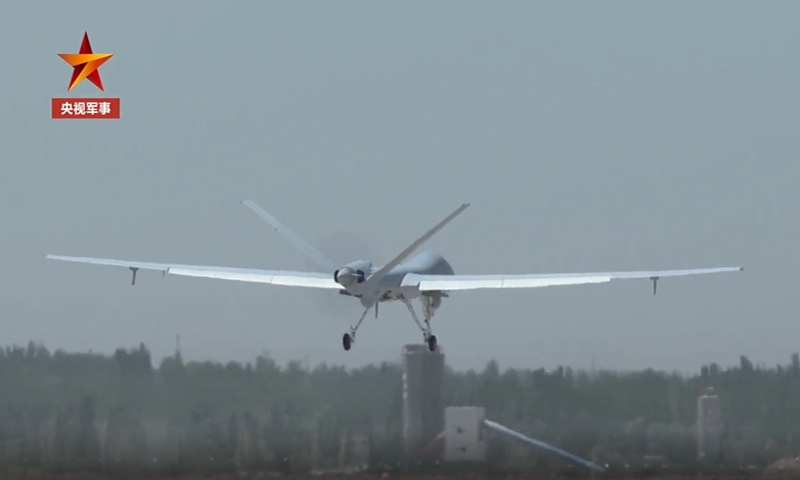China needs to hone its UAV piloting skill We just saw in Uki war UAV play a decisive role in destroying much of Western armor. Destroying the invisibility of the like of Leopard, Geppard, Marder, etc. Yup, they shattered like glass. Russia uses it with FPV cheap drones. Fighting a peasant on the camel is different than fighting a well-armed and trained Russian. But the range is short and needs to have personnel close to the battlefield. In the Taiwan scenario is not possible you have the Taiwan Straits. Therefore the need for long-range UAV Fortunately China has plenty of it. And the need to hone long lange piloting. Yup UAV is the best antidote of Taiwan's fortification providing they secure air superiority.
Here is the video
Here is the article
PLA Air Force practices new methods of drone combat
By
Published: Aug 14, 2023 09:00 PM

An armed reconnaissance drone attached to a Chinese People's Liberation Army (PLA) Air Force unit based in desert region in Northwest China takes off in a training exercise in 2022. Photo: Screenshot from China Central Television
Starting in 2023, the Chinese People's Liberation Army (PLA) Air Force has been practicing new methods of drone combat, including remote controlled takeoffs and landings and jointly operating with other military services and branches.
In a recent exercise held in the deserts of Northwest China, a GJ-2 armed reconnaissance drone conducted reconnaissance and strike training in a realistic combat scenario, China Central Television (CCTV) reported on Sunday.
The drone operators, operating the drone remotely from a location far away from the airfield, were tasked to search, detect, identify, locate and attack multiple targets within a single sortie.
This kind of remote control is a new combat pattern developed by the regiment this year, CCTV reported.
When needed, the ground station can connect with the aircraft from anywhere and complete tasks including takeoff and landing as well as other missions, Yu Ruichao, a member of a regiment affiliated with the air force of the PLA Western Theater Command, said in the report.
This means that the PLA Air Force has established a comprehensive command and control system over drones featuring long-range communications relays, including satellite communications, a Chinese military expert who requested anonymity told the Global Times on Monday.
TBH, I'm starting to think of having UCAVs that can be operated autonomously would be an absolutely great boost to the comprehensive aerial firepower of the PLA - Starting with the MALE and HALE UCAVs (e.g. CH-4, CH-6, GJ-2, GJ-3).
To be more specific, the MALE/HALE UCAVs should be able to:
1. Taxi out of the designated hangar/parking stand upon receiving mission command;
2. Taxi onto the runway and take off;
3. Head towards mission area;
4. Complete all designated missions;
5. Return to home base;
6. Land on the runway and taxi back to designated hangar/parking stand -
Completely autonomously with minimal human guidance/assistance.
~~~
In the meantime, MALE and HALE UCAVs with high levels of autonomous capabilities will also require airfields and air bases that are designed to enable, facilitate and even enhance their operational capabilities.
TBH, I'm actually thinking that China can work towards developing UCAV airfields or air bases that can function with greater automation, greater self-autonomy, greater degree of networking and datalinking between allied units and allied stations, plus involving little human supervision and involvement in its day-to-day operations, during both peacetime and wartime.
~~~
Using an example to illustrate the idea:
Step 1 - Allied ground-based early-warning radars and sensors, and/or manned AEW&C/ELINT/SIGINT aircrafts and/or drones located some distances away detected and confirmed the presence of enemy cruise missiles that are heading towards allied ground units or groupings;
Step 2 - Depending on the speed, direction, location and degree of urgency of such threats to allied units/groupings, the command to intercept enemy missiles will be sent to autonomous UCAV airfields/airbases where UCAVs stationed there are best positioned to intercept - Either by human operators, or automatically generated by the system itself;
Step 3 - Upon receiving the command, the autonomous UCAVs will be fueled, armed with suitable weaponry (air-to-air missiles, in this case), kitted with suitable radar/sensor/fire-control/communication modules, and then launched to intercept the enemy missiles - All done on their own and within a set period of time;
And finally, Step 4 - Once all enemy missiles have been successfully intercepted and no further enemy threats are present, the UCAVs will automatically return to their home airfield/air bases.
~~~
Of course, more complex tasks such as maintenance and upkeep of UCAVs and airfields/air bases, plus damage repair and reconstruction works due to operational accidents or by enemy action are still going to require greater degree of human involvement.
However, the key here is to make sure that this type of airfields and air bases can be minimally manned-and-operated, in order to allow more precious human resources to be allocated to airfields and air bases which are bigger, more complex and/or more critical to the war effort.
Last edited:
